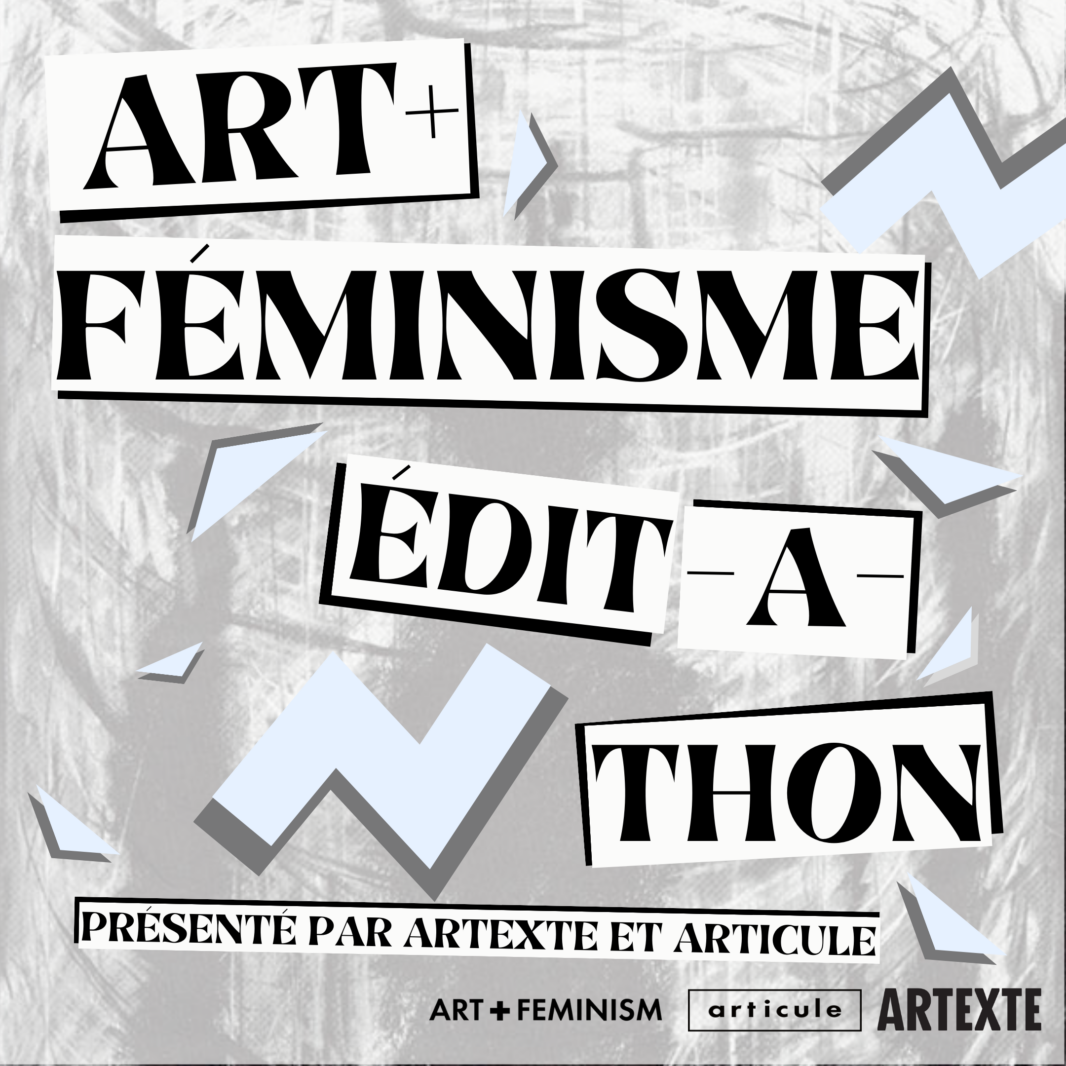Wikipedia edit-a-thon and conference
March 18, 2023 — 12:00 PM to 6:30 PM @ Artexte
As part of the Art+Feminism campaign and mission, Artexte is collaborating with Articule to invite you to join us for another Wikipedia edit-a-thon aimed at representing the work of artists, authors, and cultural workers from underrepresented groups on Wikipedia, including women, Black, Indigenous and people of colour (BIPOC), as well as people identifying as part of the LGBTBQIA2S+ communities.
For this edit-a-thon, we invite you to draw inspiration from Practice as Ritual / Ritual as Practice, the upcoming exhibition presented at Articule from March 17th to May 6th, 2023. Curated by Andrea Fatona, this group exhibition touring across Canada features the works of 10 Black women artists who participated in the historical 1989 Diasporic African Women’s Art (DAWA) Collective exhibition: Black Wimmin: When and Where We Enter (1989), the first national exhibition to address the exclusion of Black Women artists from the visual landscape of Canada. Artists DZI..AN, Mosa McNeilly, and curator Andrea Fatona will join us for a discussion following the edit-a-thon segment of the event.
Do not forget to bring your laptop (BYOL)! Charging stations will be available at all times throughout the edit-a-thon. Additionally, please sign in as an editor on our Wikipedia edit-a-thon’s dashboard to contribute to the statistics of this collective effort.
Schedule:
- 12:00 – 12:30 pm: Introductory Wikipedia training with Jessica Hébert, Librarian, Collections and User Experience at Artexte [in French];
- 12:00 – 4:00 pm: Wikipedia edit-a-thon;
- 4:00 – 5:00 pm: Coffee break and guided tour of the Desire Lines. Displaced Narratives of Place exhibition;
- 5:00 – 6:30 pm: Discussion with DZI..AN, Mosa McNeilly, and Andrea Fatona [in English ASL and ASL to LSQ interpretations available].
On-site and online edit-a-thon:
Join us at Artexte or virtually via Zoom during the edit-a-thon period of this event. Members of the Artexte team will be available at all times to assist you and answer your questions on-site and online.
Support:
In order to assist participating editors in finding reliable information sources, drafting and making improvements to Wikipedia pages, Artexte’s team members will be available to answer your questions. A selection of files on BIPOC and LGBTQIA2S+ artists will be available to the editors in order to create, translate and/or improve their Wikipedia pages.
Whether you are a Wikipedia buff or a neophyte, you are invited to take part in this edit-a-thon’s mission, which constitutes a great international effort to correct persistent biases of inequality and underrepresentation in this free encyclopedia, with respect to women, BIPOC and LGBTQIA2S+ artists.
Read Art+Feminism’s Safe Space Policy
Accessibility of the event:
During the public discussion, following the edit-a-thon, ASL interpretation and ASL to LSQ interpretation will be offered thanks to the support of the Conseil des Arts de Montréal. Artexte is a public space open for free and to everyone. Our spaces are located on the 3rd floor, and are accessible by elevator and have physically accessible restrooms. Consult our report by Kéroul for more information.
Children are welcome to this event. A certified youth leader (ACQ, DAFA, CQL) will be present to guarantee a fun afternoon! For more information, contact: collections@artexte.ca.
During the coffee break, coffee, juices and snacks will be provided.
About our guests:
At the center of DZI..AN’s [born in 1959/based in Montreal, Canada] practice is an inquiry: “What makes human vibrate”? With an interest in creating powerful forms, she has been creating life-size sculptures that encourage viewers to reflect on the human rhythms for decades. Working with a variety of materials, DZI…AN holds a keen interest in elements and materials such as earth, air, wood, metal and felt. Her interest in the thousand year-old medium of felting acts as a base material for these life-size sculptures, the size creating a familiar intimacy between viewers and the works. When working with metal, DZI…AN likens it to “drawing in space.”… I centre them on a balance point so they can vibrate in the wind”. DZI…AN’s environmental sculptures aim to invite viewers into the adventure of a moment, into an impression and may even stimulate the urge to whisper something to the objects as one is leaving.
Andrea Fatona is an independent curator and associate professor at OCAD University. Fatona was the former curator of contemporary art at the Ottawa Art Gallery, and has worked as the programme director at Video In, Vancouver, Co-Director of Artspeak Gallery, Vancouver, and Artistic Director of Artspace Gallery, Peterborough. Her curatorial practice is concerned with creating spaces of engagement for Black cultural producers in Canada. Some examples of her curatorial projects include: Queer Collaborations (1993), Across Borders (1995/6), Cadboro Bay: Index to an Incomplete History (1999), The Attack of the Sandwich Men (2001), Reading the Image: Poetics of the Black Diaspora (2006-2008), Fibred Optics (2009-10), Will Work for Food (2011), Land Marks (2013-14), Settling in Place (2018), and Winsom: I Rise (2018). Fatona is a Canada Research Chair, Tier II in Black Canadian Diasporic Cultural Production.
Mosa McNeilly (Born in 1964, Toronto and based in Hamilton, Canada) is an artist, educator, and editor. In her interdisciplinary research, she brings encaustic, assemblage, and installation into conversation with clown, movement, and voice. In her Middle Passage memory work, Mosa reimagines the poetics of memorialization. Employing hybrid iconographies, she explores community activations of her installation as an embodied mourning praxis. Reflective of a creative practice that merges with the ceremonial, Mosa’s work brings about an integration of the material with the ethereal. Grounded in the reparative labour of gathering and assembling, her work contemplates fragmentation and gestures toward wholeness. Mosa has exhibited at A Space Gallery, Harbourfront Centre, and Zig Zag Gallery, Toronto, and has performed at Lloyd Best Institute, Trinidad. Featured in Cosmic Underground Northside and Nuances of Blackness in the Canadian Academy, she has spoken at OCAD University, Dalhousie University, and Axené07 Gallery. The Hamilton Arts Council artist-in-residence 2021-22, Mosa holds an MES from York University.


